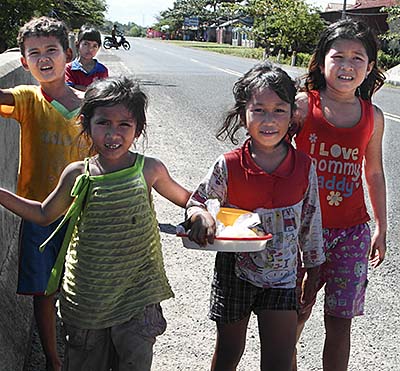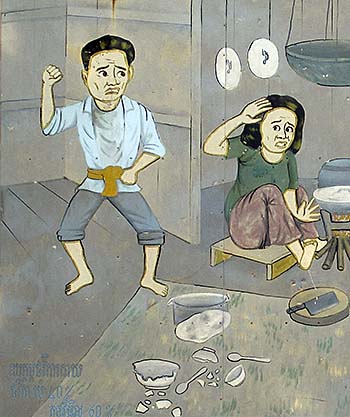1.
Khmer and Cambodians
According to official statistics are 85% to 90% of the Cambodian inhabitants ethnic Khmer. That would make Cambodia the ethnically most homogenous country in Southeast Asia. Minorities are Vietnamese (5%), Cham (3%), Chinese (ca. 1%) and some Thai, Laotians and a number of hill tribal people who are here collectively called Khmer Loeu (formerly Moi). Critics claim that the official numbers of the minorities are given too small.

The three most frequent words in Khmer language are NO! NO! NO! Means: no have, no can, no want, no care. That is truly Khmer! There is an equivalent gesture with the hand, turning it with the ankle to and fro a couple of times. I often see that already from 50m away, when Khmers see me coming and don't want any contact with a foreigner. Most of them are not exactly people who like to help, and xenophobia is clearly widespread.
Impudent and dull beyond imagination, there is usually an ambition for 'good business' (easy money) in the air. 'Farang pays, Khmer takes' is the basic attitude, and any fraud and cheat is good enough. Image by Asienreisender, Pursat, 2/2016
The Khmer People live allegedly since the 2nd century in the areas where they still live today. Where they are exactly from is not completely known, but they can hardly deny some Indian traits in their physical appearance. There is reason to suppose that they came from south India via Java, Sumatra and the Malay Peninsula into the Mekong Delta from the 1st century CE on.
Vietnamese live since the late 17th century in Cambodia, more came in the 19th and 20th. Many were promoted by the French colonial authorities who preferred to place them into official positions. After the Vietnamese occupation between 1979 and 1989 another Vietnamese immigration wave entered Cambodia. There are old conflicts between the Khmer and the Vietnamese, which sometimes errupt in anti-Vietnamese pogroms.
Chinese live at least since the times of medieval Angkor in Cambodia, particularly in the cities as traders and craftsmen. Until 1975 Chinese business dominated the economy and the traffic system of the country, but they got heavily persecuted by the Khmer Rouge and many of them were killed, so far they couldn't escape. Since the early 1990s Chinese come back and gained meanwhile again an important economic role.
Cambodian Monks and Novices

A group of Khmer monks and novices at Nokor, having lunch together. Buddhist monks are allowed to eat until high noon; afterwards is fasting time. Many of the boy kids from poor families are given to the temples, where they grow up and live from alms donated by the neighbourhoods. Image by Asienreisender, 2013
The Cham People are Muslims. They live mostly along the lower Mekong River. Between Kratie and Kampong Cham / Phnom Phen are many of their mosques to see along the road. Their old empire, a long-term rival of the empire of Angkor, was destroyed by the Vietnamese in 1741 and part of the Cham fled then into Cambodia. Traditionally they are cattle dealers, butchers and silk weavers. Butchering, by the way, is for the Buddhist Khmer according to the Buddhist rules, not allowed. They only eat the meat afterwards. It's not their fault that the animals anyhow died, as they see it...
There are two other Muslim minorities living in Cambodia, who are often seen as Cham, but are not. In the coastal regions of Kampot, Sihanoukville, Sre Ambel and Koh Kong live the Chvea. They came from the southern parts of the Malay Peninsula, what is nowadays mainland Malaysia, the south of Thailand and Sumatra in the 14th and 15th centuries. They are mostly fishermen and seafarers, and their boats look very similar to those one sees in the Malay Archipelago. They were already Muslims when they arrived in Cambodia, and it's supposed that they converted the Hindu Chams to Islam.

A Khmer house at the riverbanks of the Mekong River in Stung Treng. The sleeping place is in the background. Image by Asienreisender, 2013
In Kampong Tralach and Kampong Chhnam live the followers of Imam San, a Muslim sect which has the most relaxed and tolerant rules among the Cambodian Muslims; they allegedly pray only once a week, for example. Imam San lived in the 19th century and it's said that he is burried under one of the stupas on Phnom Udong.
All the three Muslim groups are Sunnites.
The Khmer Loeu are by a certain part old tribal Tai People who live in the mountainous regions bordering Vietnam and Thailand. Others seem to have rather Polynesian roots. They live traditionally half-nomadic, grow rice and vegetables, cultivate a sustainable slash-and-burn agriculture, keep cattle and are animists. Their livestyles are very much under pressure now due to the loss of their natural surroundings (particularly the ruthless landgrabbing practices in Cambodia; see the description on the Ratanakiri page and the events in the Areng Valley).
One shouldn't forget to mention the expat communities of Westerners in certain spots of the country, namely Phnom Penh, Siem Reap, Sihanoukville, Kampot, Kep and a few other places. They are a minority, but have some influence on the local economy and coin partially the street live in these places.
The majority of the Cambodian people live in the plains, the mountainous areas are partially almost uninhabited. Only 20% of the population lives in the cities; that's still an aftereffect of the Khmer Rouge's politics, who evacuated and destroyed the cities.
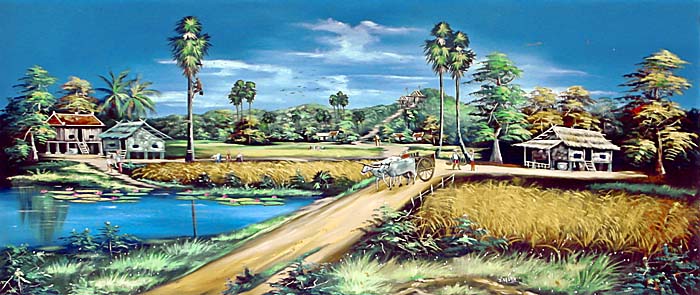
A typical rural scene in Cambodia. Simple cottages, dirt roads, rice paddies, ox carts and much water. 80% of the Cambodian people live in the countryside. Painting seen in a hotel in Kratie. Image by Asienreisender, 2013
The contemporary Cambodian society is the result of a complete civil breakdown in the 1970s and the following years. The total destruction of the country and civil society in this time explains many of the appearances and nuisances in the country. It's a society in which poverty and injustice are so big, that the permanent struggle for survival dominates most of the peoples lifes. Anomie is widespread, the strong ones have the right on their side. Strength is alway based on money and political influence. As the Khmer Rouge got away with genocide, the Khmer Rich, that's what the Khmer Rouge are now after a face-lifting, get away with all kind of crimes against humanity under the ruthless Hun Sen Regime.
2.
Violence
An in 2014 published report of the UNICEF in cooperation with other institutions shows a high level of all-day-violence in the Cambodian society. It seems to be the first systematical study of the problem. More than 50% of the Cambodians suffer physical violence in their childhood, additionally to psychological cruelties and abuses. 5% suffer sexual abuses. The offenders are mostly family members.
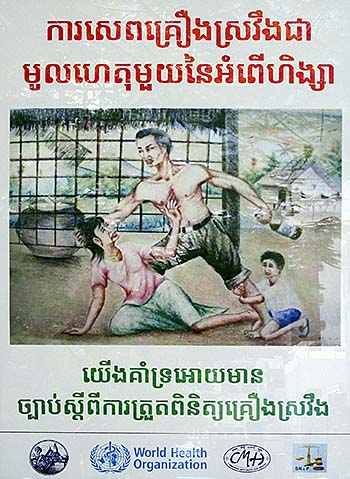
A UN poster in Phnom Penh, alarming on alcohol abuse and family violence. Image by Asienreisender, 8/2015
Violence, particularly against children, causes psychological problems of a great variety. Many kids get depressive, suicidal, not seldom infected with contagious diseases. Post-traumatic stress disorders are widespread. Kids and their families get stigmatized. In rural areas it's seen as a 'must' for a man to beat his woman from time to time, to show who is the boss. And in this society little can be done against the offences. Which child can accuse or sue it's own parents? The family is the basic social unit. Without family, one is nothing, in a traditional society more than in the West.
If there is a problem, let's say an accident, the wrongdoer, let's say a bus, truck or car driver, will most probably flee the place. He has to fear the violence of the victim's family. People get killed for such reasons. If there are corporate accidents with victims, those in office are usually not to speak; they are not to meet in their offices nor do they answer the phone. The police takes bribes for filing a report and do practically nothing more. In bad cases they prosecute the victims.
Not seldom does child abuse happen in public situations with witnesses around. However, usually nobody dares to interfere, for the offenders could turn out violent against those who try to help. Most people here are indifferent against anything what happens. Not seldom are people around who laugh and enjoy it when they witness violence. Other people's harm and damage is a source of joy for many Khmer.
Political violence, political murder and arbitrary detention happen often in this country; it's directed against oppositionals, regime critics, minorities in cases of land grabbing and environmental activists who take action against the corporate rape of the nature. Examples are manyfold, like the cases of Chutt Wutty, Chea Vichea, the activists of 'Mother Nature' in Koh Kong and many more. In July 1997 a 'mini' civil war happened in Phnom Penh, when the private army of Hun Sen and that of then first primeminister Ranariddh clashed and ravaged part of the city. Hundreds got killed and tortured, most of them from the FUNCINPEC Party. Also on local level human rights activists get intimidated, beaten up or thrown in jail for raising their voice against the government or the activities of corporations. The best people get killed or heavily oppressed. One hears little of them, for they have to be very careful and have little of a public voice.
3.
Children
It's often remarked by Westerners that the kids in Cambodia look so happy. That's so. However, kids usually look happy, except maybe noyadays in the west, where they live so artificial, estranged and are often spoiled and/or neglected. Cambodian children grow usually up without restrictions. They can do, what they want. Recently I read an article of a Westerner who lives in rural Cambodia. He called the Cambodian kids semi-feroucious. In fact, they gather every day in bands and stroll around in the neighbourhoods. What they learn, they learn by a great deal mutually from each other. Peer socialization. Nothing against it, to a certain degree. Depends on what they do, of course. The trouble here is, that the adults don't explain or teach them more than some very basics, if anything. They don't set limits for wrongdoing. Communication is generally poor. Nobody explains or justifies his deeds. The people here just do what comes spontaeously into their mind. Worse: they generally don't care at all for the consequences for anybody else. Unconscious and irresponsible. The kids see and copy that.
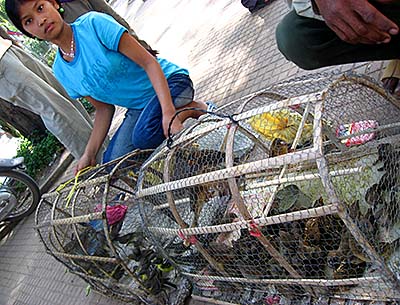
Instead developing her potentials as a growing kid in the age where learning is easy, this girl has to sell bird's freedom to bypassers. It's seen as a good deed, adding good kharma, to buy a caged bird and let it free. Soon later, the bird will be caught and sold again. The bird's don't last long... Image by Asienreisender, Siem Reap, 1/2007
When being around in the countryside, many of the kids I see behave illmannered. The usual 'Hello, hello!' appears in many variations. 'Hello you!', 'Hello farang!', 'Hello money!' (shortform: 'Money!'), 'Hello pay!', 'What's your name?' and more. Also that: 'I want to fuck you!' (heared from eight years old boys). One afternoon, girls of about ten years old from Kampong Bey School in Kampot asked me repeatedly: 'Can I fuck you?'. They couldn't stop giggling and laughing. Soon later all three had to pass me on their bikes, and they all ended up in the water trenches to the right and left of the road, because they were laughing so much that they lost control over their bicycles. Happy kids, right? Drug abuse, by the way, is rampant also among the youngest.
It's also odd, that the kids are allowed to ride the family motorbikes in an age so young, that their legs just reach the pedals. Eight year old boys with one or two smaller kids behind them drive. One evening I watched such a triple on the dirt roads east of Kampot town. There are here and there 90 degree curves in the roads. While chatting, the driver didn't see the next curve, and went with unreduced speed into the next rice field, which was under water. Not only that the kids are too young to drive, they don't get any instructions either. Khmer don't need to learn. They know everything by nature.

Here and there hang posters with hotline numbers for reporting cases of child abuse. Image by Asienreisender, Kampot, 9/2014
Kevin Bales dedicates a whole chapter to human trafficking in Thailand (Bales, Kevin: 'The New Slavery'). He shows that many people sell their kids into slavery for ridiculously little amounts of money. Sometimes they do nothing better with it than to buy a TV or karaoke set. Particularly families who are in debt come under pressure and need money to pay their monthly rates. Much of the consumption and the economic growth in Cambodia is just based on a debt bubble. Also here do many families sell their kids into slavery. Certainly the situation is much worse than in the far richer Thai society. Girls (and boys) are given to brothels or are sent into orphanages. A considerable part of these orphanages, who are run as any other ordinary business, need all the time new kids. Families can rent their kids into these places. They are no orphants, but they bring money as such, so they are given away or hired out. Many of these places keep the kids in very poor conditions, violence is not seldom. In the worst cases, orphanages serve as child brothels. These Western businesses make their profit by fund-raising in Western countries.
In early 2016 I spent some time in Koh Kong. On the way from my hotel to the restaurant a little girl approached me and touched me and pulled on my clothes. I told her to let go, but she continued. I repeated louder, but without any result. I didn't know how to help myself otherwise and slapped her; she started to cry, but stopped intruding me. Two days later I made the same experience at the same place with a small boy. They came from an orphanage at the spot. I bet on, they are trained to do so. It's a method to blackmail Westerners for child abuse.
Many of the kids are underfed, and diseases are not recognized or mistreated. Whooping cough, inflammations of the middle ear or damaged eardrums are among many other frequent health problems. Allegedly 80% of the people with hearing deficits live in the tricont, the so called 'Third World'. In Cambodia alone it's two millions, and half of the cases could have been healed due to prevention or treatment. The official health statistics don't record that; it's all fine in Hun Sen's Cambodia. Therefore they tune the music full scale and particularly the basses, to feel what of the din.

Houses along a tributary of Kah Bpow River in Koh Kong. There is more garbage in the stream than water. Imagine the stench - or no, sorry, better don't do that! The surroundings are all a big mess, chaotic, neglected, filthy, unplanned... nobody cares for the consequences of his/her deeds. It's the habitat in which the next generation grows up. Image by Asienreisender, 2/2016
The general social climate in Cambodian society is coined by a great ignorance and disrespect of anybody else. It's not only so, as I described already, that foreigners get cheated at any corner. That's a general phenomenon in Cambodia. Everybody cheats and lies at everybody, and that does not stop within the family. The bulk of the Khmer is so dull, that they have not the faintest scale for right or wrong, so that they operate on the lowest possible level. Right is, what they believe is right. That's the only point. This rotten mindset is transferred from generation to generation, and there is no turning point in sight.
One should add that, generally spoken, the women are better here than the men are. While the men in many cases are just totally irresponsible and have only their own fun in mind, what is to please with gambling, drinking, whoring, excessive partying and laziness, the women are the ones who take at least a minimal care for the families. The girls help their mothers and do what in the household. The women are also the ones who have the upper hand on the family money. In financial decisions they have much influence.
However, 'better' means not necessarily good. I witnessed a lot of bad gossip here, what is much of a female domain, and malicious women with their bad taking, spreading rumours and lies, do a lot of harm on other people.
4.
Happenings in All-Day Life
It's curious to see the people behaving in all-day life. One sees so many things who are definitely a 'don't', a thing one learns already in youngest age one should never ever do. That's no point here. In Cambodia, in best postmodern manner, anything goes.

A warlike scene: people set inmiddle of a neighbourhood a tractor tyre in fire. Nobody seems to find that odd. Images and photocomposition by Asienreisender, Samraong, 1/2016
A few examples. At one of the many weddings there was, as it is usually here, a lot of rubbish of all kind thrown around. Someone swept a part of it up and threw it into the water trench in front of the house. The water trench is actually part of the wastewater drainage and should be kept free, but neighbours throw all kind of rubbish into it, until it's blocked and filthy, stinking water dammed-up in front of the houses.
However, in this case the rubbish, mostly plastic, was burned, while the wedding guests were sitting just a very few meters away from the fire. The thick plastic smog crept through the garden over the tables. No one would ever complain or move.
Besides, partying always, always comes with an incredible din. None of the party guests is interested in having anything like a reasonable talk. The din doesn't allow conversation. It's obviously also that nobody likes music.
The other day there was a party next door where three boys under the age of ten made the 'music' on a laptop. They clicked more or less uncontrolled with the mouse here or there, this track - click - than another one - click - and the next one, without listening. All that extremely noisy, the basses on maximum. The loudspeakers are anyway usually broken. Shrieking backcoupling appeared again and again from a microphone. Directly aside was a table with the adult party guests and the hosts. Nobody set the boys a limit.
Recently, on a trip from Phnom Penh to Kampot, the passengers on the van were in a good mood and talking lively to each other. Much laughing, good atmosphere. A chicken appeared on the road, panicking and running zick-zack in front of the car. Wouldn't have cost the driver too much effort to let go the accellerator for a moment, but he didn't. Hitting the animal he uttered a cry of joy. One of the passengers in the pack was crying applause. The others showed signs of excitement and agreement. Turning my head I saw the animal being heavily hurt and probably dying behind us. These people enjoyed to hurt and kill an innocent being for no reason. That is typical Khmer. A thousand times I had to witness cruelty to animals, and it doesn't stop at animals - it's practiced often against anyone who is weaker than the offender. It coins the social character of Cambodian society.

Party, party, party and no end. In dry season there is almost every day party din around. Weddings, funerals, karaoke or any cause is invented just to have a party. Often it comes from several sources. Having a karaoke bar in the wider surroundings is fatal. They cause every evening a deafeaning din. It's as if the whole society's insanity is howling up to the sky. BUM BUM BUM - the sound of the wardrums, Khmer culture. It's the best, they have, although some people think more BUM BUM BUM BUM BUM were even better. Image by Asienreisender, Kampot, 8/2014
Khmer society is traditionally coined by a deep necrophilia. Well, they had their heyday under Pol Pot, who was in many concerns just a typical Khmer. My protest wasn't met with understanding. The driver blamed the chicken. Victims are usually blamed, because of their weakness. That's the same people one sees then at religious events in their Buddhist temples, being good and faithful believers. Bribing Buddha for getting rich.
Imagine a man who unmounts from his motorbike with a straddled leg inmiddle of the crowd. He hits someone at the hips. One would expect him at least to say a short 'sorry'. But nothing comes - it's as though he didn't notice it. Total ignorance and antisocial behaviour are common Khmer attitudes.
Imagine you are in a hotel and hear penetrant music and someone shrieking (trying to sing) penetratingly. It doesn't cease and wondering what's up you go and have a look. It's the cleaning boy, having a good morning. More din comes from a mobile phone in his pocket and the abominable rest out of his mouth. Forget about asking him to stop that, because it's disturbing for him. You are only the guest and the egocentric is above you - so you have no rights. If you don't like it, you can go. Your problem. The guy is on drugs. Useless to complain at the reception; they would't see a problem either. Khmer reason. Later you see that he made a most sloppy job and forgot lot's of things to do. It's all okay here, within normality.
You are in a restaurant. Everything is filthy and neglected, the floor littered with rubbish and no one cares. Next table sits a group of people eating like swines at the trough and spitting on the floor. Another normality in the 'kingdom of wonders'.

Public school is often supplemented by additional coaching in the late afternoon or early evening.
Despite (or because?!) the opening of many Hun Sen schools all over the country, the education system remains extremely weak. School is not coined by learning, rather by cheating and bribing the teachers. Image by Asienreisender, Chambok, 4/2015
Imagine being in a hotel and hearing noises from the neighbouring room who are no more humanlike. They shriek and cry in the most unnatural voices. That happens usually late at night. Next door is a party, often youngsters who go with four, six or eight people into a double room and drink and take drugs (ice). You can go and knock at their door to ask them if everything is 'okay' or if they need any help, but they won't open. The night is done, and when they start strolling around on the hotel's floors it's getting even worse. The hotel's management and staff remain in such cases, as always, ignorant. Interfering can turn out dangerously, conflicts have to be avoided. If you manage to have a glance next forenoon into their room after they left, you see the perfect mess. Litter all around, empty bottles, vomit on the floor. That was a great party. There is little space for privacy in this society, where particularly youngsters can escape the eyes of gossipers. The trouble is, that anything turns out so abusive.
Let's say it's a more or less beautiful morning (in the countryside the mornings are often very beautiful in Cambodia). You don't mind the roosters but, there is something more. Local men are cleaning their throats. They do it long and excessively. It sounds like something between a dying swine and a vomiting drunkyard. That's a daily standard in this society. Not only in the countryside.
In May 2016, when I was jogging on a remote side road, a dirt road in the countryside at the foot of Bokor Mountain, one of the big Lexus pickup trucks appeared behind me. I moved to the left side, and there was plenty of space left for the vehicle to pass by. However, it came too close and hit me. There was no space left for me and I banged with my hand against the car's door. They just went on. The road was a blind one and at the end is a Buddhist temple. Soon later I saw the car there on the temple ground. On the way back they came again behind me. I stopped the car by blocking the road and told the driver that he had hit me before. The usual answer: "No!". I tried it five times, and got five 'no's' back. At the end, one has to be careful not to be beaten up, for there were four people in the car and I was alone, and there were no witnesses around.
There were countless of cases in whole Cambodia, when I entered a restaurant or a shop and greeted with the usual "Sok Sabai" or "Hello" and didn't get any answer. Trying to establish eye-contact failed. Asking the shop assistants or owners about some items, they completely ignored me. I had difficulties in Anlong Veng to get food, and in Ou Soum I lived from my iron ration of peanuts because of the local's ignorance and the limited choice of restaurants.
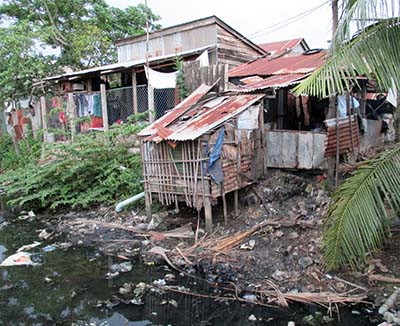
A large and growing part of the population lives in slums. Even a town as small as Kampot has a slum belt around town. However, slum or not, the houses are everywhere surrounded by an enormous and also growing amount of filth and rubbish. The environment people create around themselves are an outer representation of their inner constitution. It gives a reliable mirror of how it looks inside their skulls. Image by Asienreisender, 5/2015
On any kilometer I drive on a Cambodian road I meet several vehicles approaching on the wrong roadside. Bycicles anyway, mostly motorbikes, also cars, here and then a bus or a truck. They always stick close to the roadside and try to bring me into a 'sandwich position' between them and the traffic behind me. I do drive closely to the roadside as well then, and it mostly ends with a steelmate - we block each other. If they would cause an accident, I am pretty sure, they would blame me. Sometimes there come as many as three, four, or more at once. Traffic in Cambodia is completely anomic, no rules, no accountability. The bulk of the Westerners who I watch here in Cambodia adapt quickly to the anomic driving style of the locals and don't do any better.
In December 2016 three Khmer kids approached me on a side road on their bicycles. I was on a bicycle as well. The three were chatting and, as so often, didn't care for the traffic. One of the boys collided directly with me and fell. From a restaurant at the roadside sounded loud laughters. A man couldn't stop amusing himself about the event. No question if there was any injury or damage. Khmer humour is - ha ha ha! - when other people suffer harm.

Overcrowded, crammed with stuff of all kind, smelly, noisy, incredibly filthy - Kampot Fresh Market is a typical Cambodian market like they exist in any town in the country. A hell of a place to go. Image by Asienreisender, 4/2015
Cambodian Dentists
Remarkable are also the Khmer dentists. I write a years-long negative record on them. The trouble started when feeling a hole in a tooth which ned a simple filling. There are plenty of dentists everywhere in Cambodia; often they operate on the level of hairdressers. I have seen dentist clinics here who were integrated into street restaurants. Sometimes the places are as dirty as a swine's stable. I went to someone looking professional. He made me a filling, and everything seemed to be fine; after a time pain appeared, though. What happened was that he didn't desinfect and an inflammation appeared inside the tooth, sealed by the new filling. I asked many, really many Cambodian dentists for 'desinfection' and never found one who knew the term.
However, the pain grew worse and worse, and I couldn't sleep anymore. To find professional treatment, I went to Phnom Penh, visiting 'Roomchang', a large dental surgery who makes expensive advertisements in the media. It's a place where the international diplomats and wealthy businessmen go. Their English is fine and everything looks highly professional and rich. They explain in detail their diagnosis and behave trustworthy. First thing to do in my case were x-rays. The assistant went with me to the x-ray room; unfortunately did she make so many mistakes that she had to do eight x-rays instead of two or three to get usable results. So, it started for me with getting a high dose of radioactivity.
The dentist then showed me the results on the computer screen and gave me detailed explanation and treatment advise. It would be a root-canal treatment and a second tooth would be pulled out. Alltogether a long, painfull treatment what would last over three days and cost me about 1,200 US$. Quality. Didn't make me too happy, but I was suffering severe pain since days and didn't see an alternative. However, treatment could't start right now, because the dentist had to have his lunch break first. So, I used my time to visit another dentist who I got a recommendation from an aquaintance before. She was Chinese-Cambodian and gave me a special antibiotic for five dollars, which cured the inflammation below the filling in one tooth. Spared me the root-canal treatment. The other tooth, a corner tooth, had apparently another hole which I could feel with my tongue. While Roomchang recommended me to pull it out, I was ambitious to try to cure and rescue it. I went now from dentist to dentist, alltogether four different clinics, and asked them clearly if there would be a hole in the tooth. They all denied that and claimed that a root-canal treatment would be due. I had to go as far as to Chanthaburi in Thailand to find finally a dentist who had a look on the tooth and told me: "Hey, there is a very big hole in your tooth." He fixed the problem professionally within minutes and the bill was modest.
More than a year later I lost a bit of a filling at a corner tooth. No pain, but these things should be done before more of the tooth breaks apart. It was such an easy treatment that I dared again to go to a Khmer dentist. I explained exactly the problem, named the tooth and hoped the best. The dentist took a driller and drilled far too long and caused an immense pain. When he told me to flush, I spit blood, blood, blood. My tongue went to the tooth, but there was no difference to feel. My tongue glided to the neighbouring tooth, and there was a deep hole. The fool opened a healthy tooth...
Next thing he told me was that the hole was now too big to be filled, and I would need a root-canal treatment. I denied that and insisted on a filling. He did as I said, forgot the polishing (I had to tell him) and I went home with toothpain and a pretty bad headache. I went to bed early this day, half past seven already, to find some peace. Next day the headache was gone, but the tooth was extremely sensitive to pressure, so that I could chew only on the other side. It lasted two weeks until the pain completely ceased.
I believe, by the way, that the dentist did treat the false tooth by purpose. A filling does not bring them much money, it's cheap. A root-canal treatment costs hundreds of dollars, that makes money. I think, they learn that in their schools. My experience is that Khmer dentistst all-too often advice root canal treatments, or to pull out a tooth, althoug a simple treatment like a filling would help. And again: hygiene (namely 'desinfection') is an alien concept for most of them.
Just to give an idea of how qualified the specialist are in the 'Kingdom of Wonders'. My personal experience with the Khmer is, and that's covering all professions, whatever they get into their fingers, they mess it up. They never skip a mistake. Must be part of the national pride of the magnificent Khmer.
More from the papers....
It's also curious to read the papers as the 'Phnom Penh Post' and 'Cambodia Daily'. Every few days there is a very weired story to find in them. I give only a few examples from the first half of 2014.
A man who stole in a market stall got killed by some shopkeepers. They beat him down with bamboo sticks until he was dead. That happens sometimes with thieves, for nobody trusts in the police.
A man has been killed by a mob of angry villagers. He was blamed by them for committing black magic. In another case a woman has been hijacked and brutally killed by two men and another woman. She was accused to be a witch.
A reporter wrote an article about a lake in a natural protected area, where some villagers did electro-fishing. After the article was published, twelve of the fishermen arrived at the house of the reporter in Phnom Penh and waited until he came back home from office. They attacked him with sticks and knifes. Fighting on the public road happened. Family members of the reporter heared the noise and came out to help him. The reporter got finally killed and some of his family members injured.
A villager lost 3,000 riel (the equivalent of 75 US cents) in a well. He tried to get the money back, climbed down and drowned. Another six people climbed down after him and died also. Most of them were children.
In mid-2014 a burglar tried to steal a bicycle from a 31 years old Dutch woman who lived in Phnom Penh. The woman surprised him red-handed. Instead of just running away, the man grabbed a screwdriver and stabbed the woman many times until she died. Then he stabbed her two years old daughter a lot of times as well and killed the baby.
There is no end of stories like this, who are barely believable. However, it's part of the social reality of the contemporary Cambodian society.
5.
Police
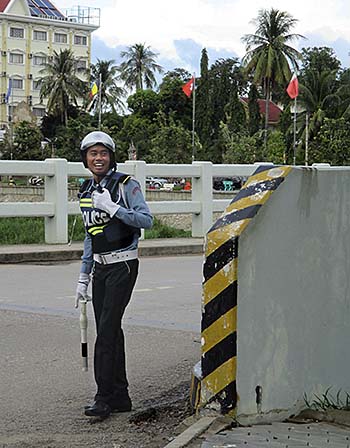
A young traffic policeman in Battambang. Seems to be a beginner. Image by Asienreisender, 9/2015
The French explorer Henri Mouhot, who travelled Cambodia in 1859/60, gave interesting records of the people of Cambodia. Reading Mouhot, it seems that in the last 150 years not much changed here. He described the duty officers, for example, as licenced beggars. They abused their power over the travellers to get some 'rewards' out of them. Rewards for not being more impertinent. Duty officers still often abuse their power to squeeze some extra dollars out of travellers today. One simply needs the visa stamp, right? Don't bribe them, and you can't enter the country, although all the papers are okay. It's the travellers problem then, not that of the officials. Mouhot also described the piracy along the southern coast of Cambodia and the protection the criminals got by the then king of the country, Ang Duong.
A similar thing happens with the police. Visiting the Kampot police headquarter in 2014, a large place with a big square in front and huge administration buildings, I found it inside completely empty. No soul was there. Walking along long hallways, all the doors to the right and the left were closed. There was also no reception desk. Finally I found the police in the backyard. A few guys, some in uniform some without, sitting at a table and playing cards. They were reluctant to talk to me.
Let's have a look on the traffic police. When I move around in Cambodia, there are always policemen at certain points at the roadside. They have but one interest: to stop buses and trucks to receive money. So far I see, that's all what they do. On my last trip from Kampot to Koh Kong the bus was stopped seven times, and each time the conductor gave a policeman 2,000 riel. Altogether 3.50 $US. No doubt who pays that at the end. It's put on the fare.
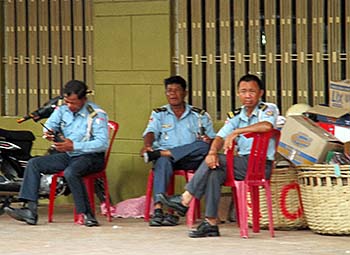
Policemen in the center of Kampot. Image by Asienreisender, 3/2015
Rumours say that someone who want's to become a policeman has to pay for that. He has to pay for the uniform himself and, some sources claim, the wage is going to his superiour. That's anyway pretty little, between 80 US$ and 120 US$ per month. However, many times little makes one big, and that's flowing in the pockets of a higher ranked policeman. Not all Cambodians are that poor. The low-ranked policeman now has to make an income by milking civilians. What happens here are examples of licenced robbery.
It's also curious that, as I have been told by Cambodians, the police charges for those who have their vehicle's lights on at daytime. They don't charge for those who drive without lights on at nighttime. Foreigners are due without helmet. Usually they don't stop foreigners, for they avoid to have to talk in English.
So, after all, the thrilling question is: does the traffic police do any good at all?
Once I had a mechanic in my house to repair a washing machine. Before he went to work, he went into my garden with a plastic bag and took a number of passion fruits from there. Just so. Later, when I was in a neighbouring room, he went into my kitchen and opened my fridge without asking for permission and took a bottle of water. Later I told that to the leader of the Immigration Police in Kampot and asked him how he thinks about it. He told me it's a common custom in Cambodia, if people are hungry and thirsty, that they can take what they need.
The mechanic, by the way, failed miserably to repair the washing machine.
6.
Weddings

An event, seen almost every day in Cambodia, are the plenty of weddings. Big outdoor parties with huge tents blocking roads, even main roads, completely. Even a walker can't come through anymore. Here it happens on the central boulevard in Kampot. Images and photocomposition by Asienreisender, 2/2014
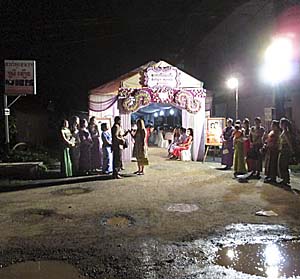
Another wedding party. Passage is completely blocked. Image by Asienreisender, 12/2014
This attitude, by the way, mirrors perfectly the Southeast Asian's relationship towards public property: there is none. You take, what you can, for yourself. This mentality is rampant, and it helps to explain the very high level of corruption here and it's general acceptance.
There is a huge marriage industry at work in Cambodia. After the rice harvest in December there are countless marriages. A marriage is expensive. The whole organization costs at least 2,000 $US, often 5,000 $US or much, much more. It's about status, and many couples start their married-life in debt. For the purpose of representation are special costumes required, as well as for bride and groom as for the guests. Marriage taylors who sell or also often rent those costumes earn a great deal of money with it. A bride not seldom has to change her clothes a couple of times per day in the costume festival.
Additionally there is a catering service for large party tents, tables, chairs, food and all the other requisites for such an event.

A wedding invitation with money envelope. Parties in Cambodia are business and cost the guests entrance. Image by Asienreisender, 6/2015
As any party in Cambodia, the guests get with their invitation an envelope in which they have to put money for the hosts. On the envelope they fill in their name and the amount of money they gave. In this way they are all set in competition with each other. Who gaves most, enjoys the highest status in this affair. It often happens that the given amounts are announced publicly by loudspeakers...
The next step are babies, babies, babies and more babies. Cambodia's population grew in the 35 years between 1979 and 2014 from 6 million to over 14 million people. The number will double again within the next 20 years. The verymost of these kids will have no decent future and live a life in poverty, ignorance and remain as mannerless and dull as their parents are.
These ever ongoing wedding parties cause an enormous din, penetrating the neighbourhoods over square kilometers and leave always an enormous litter.

This was a bombastic party, a party like a hurricane, like an earthquake. What's left, was left for the wind and the birds. Nobody cleaned what up here afterwards.
The image bottom left shows another wedding party tent. It's already filthy, before the party starts. In fact, all the parties, marriages, funerals, karaoke-outrages and whatever these miserable people do, are always of the same kind: loud and dirty. One crappy party is following the other: more reasons for excessive partying are Khmer New Year, Chinese New Year, conventional New Year (following the Western, Gregorian calendar), songkran (the water festival), king's birthday (three days) and many other, irregular causes. These holidays last usually officially three days, often stretch up to a week; the hardboiled pary a fortnight. If a holiday falls on a weekend, it is delayed into next week to guaranty a maximum length of work-free, party days. Alcohol and drugs are used in a rampant manner, the extremely low driving style deteriorates more and traffic accidents skyrocket further. Images and photocomposition by Asienreisender, Kampot, 4/2015, 2017
7.
Lying and Cheating
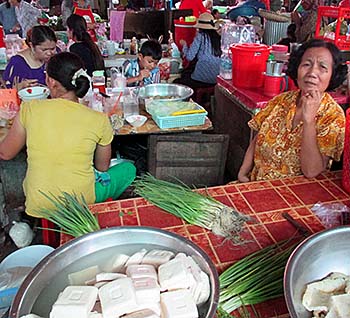
A food stall in Kampot market. The woman tried a common double cheat at me. First she asked for a price too high for her tofu; knowing the price I had to correct her. Next she gave me change back for 10,000 riel while I had given her 20.000. I had to become very clear to get my money back. Of course, from now on this shop is excluded from buying there anymore. The trouble is, that these and many other cases of fraudulent, ignorant and impudent behaviour lead to a great number of shops where one can't go anymore. In any place in Cambodia who I visited, quickly the number of such shops and restaurants rose - often from the first day on.
Another example is the purchase at vegetables on another stall. After having made my choice, the saleswoman was putting all the different vegetables in one bag. I didn't control that, because I was busy to count the money to pay with (big mistake, one has always to have an eye on what the Khmer do). When I came home, I noticed that the carrots were missing and two of the five onions gone... Image by Asienreisender, 11/2016
To speak for me personally, I get cheated in the restaurants for breakfast, lunch, dinner and anything I order - the bill is most of the times higher than expected, for the waiter made a mistake or I got something I didn't order, what is always more expensive than that what I ordered. I get cheated with the change, I get cheated for my room or house rent, I get cheated when hiring a motorbike and at the petrol station. At any business transaction the risk of being cheated is very high.
One can explain that with deprivation and poverty, of course, many Cambodians struggle for survival (while others struggle with what to do with their robbed fortunes). The educational level in Cambodia is extremely low (in fact it doesn't exist). Nevertheless, after getting wealthy, the habit of greed and cheating remains. The Khmer Rich are the worst - they prey on the whole nation and country relentlessly. They accumulated enormous riches within a few years and are profiting from international donators who don't set them sufficient limitations. That's no more to explain with poverty, is it? In all-day-life and anything I hear from other people and get from the news, Cambodians appear as a shameless people of liars, cheaters and cadgers. A morally and intellectually retarded nation, the Khmer are. I am sorry for the very few exceptions among the Cambodian People who are doomed to spent their whole life here. Decency has no chance to develop in such a rotten environment, in such a sick, sick, sick society.
8.
Khmer Pride - Ultra-Nationalism
Another observation is the extreme nationalism of a considerable part of the Cambodian population. Even in 'harmless' conversations it's sometimes uttered by Khmers that Cambodia has to become a 'strong country' again. Khmer pride. That includes a severe aggression against other nations.
Cambodia - from
Empire to Survival
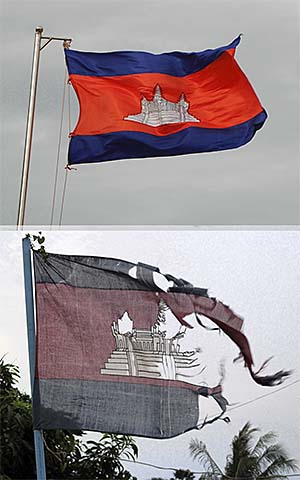
The Cambodian national flag. Any regime of Cambodia used Angkor Wat on it's flag as a central national emblem. Images by Asienreisender, 2014, 2015
The hatred against the Vietnamese is notorious. A revealing example: in July 2014 an official from the Vietnamese embassy uttered in a statement that the Mekong Delta "is an integral part of Vietnam". That's actually a banality. Nevertheless, a crowd of 200 furious Cambodians gathered at the Vietnamese embassy and demonstrated against Vietnam. They claimed the territory was always Khmer but was given by the French to Vietnam. That's factically wrong. My general experience with nationalists is, that they in verymost cases have a very weak knowledge of history, if any. The protesters demanded an apology of the Vietnamese government. When the police dissolved the demonstration it came to a clash in which several people were injured.
The radio broadcaster 'Voice of America' reported on it's website that the protests were initiated by a 'Cambodian Students and Intellectuals movement'. While intellectuals and students in former decades were rather progressive, nowadays they are merely reactionary.
Factually the Vietnamese conquered parts of the Mekong Delta (Cochinchina) in the 18th century. Historians agree that a weak and dying Cambodia in the 19th century was only rescued by French colonialism from being shared between the two stronger neighbours Vietnam and Siam. (See also the article 'Cambodian History'). Without the French intervention this country wouldn't exist anymore.
Phnom Penh Riots
In 2003, a Thai actress allegedly claimed that the site of Angkor would belong to Thailand. This false statement was published in a Cambodian newspaper. It triggered the 2003 Phnom Penh Riots - the Thai embassy was raided by an angry Cambodian mob, as well as several Thai businesses in Cambodia were vandalized (e.g. the offices of Thai Airways). The official relations between the two countries came under tension, the borders closed (for Thai nationals and Cambodians only, for all other nationalities the borderpoints were still open), and Cambodia agreed later to pay a 6 million dollar compensation for the raided embassy.
There is an old antagonism between the Siamese and the Khmer. The first Siamese city states were tributaries of the then mighty Khmer empire. However, with the rise of Sukhothai and particularly Ayutthaya, Angkor got powerful rivals who eventually succeeded to conquer the Khmer capital Angkor Thom in 1431 CE. Angkor never recovered from this defeat. In the following centuries large parts of north and west Cambodia came under Siamese rule. That was so over most of the 19th century as well. France forced Siem Reap and Battambang out of Siam in 1907, because colonial France wanted to 'own' the impressing sites of Angkor for prestigious reasons.
Nationalism is always a pseudo-religious, artificial concept. It's always stressing the 'grand times' a certain nation had. In Cambodia it was the ancient world of the Angorian empire. These times are over and will never revive, doesn't matter how much the mob cries for it. Remarkable is also the severe lack of historical knowlegde by the so very proud nationalists. They stick to myths and legends, not to facts and knowledge. At a closer look to the oh so glorious past it would turn out that most of those who are so proud now would have led a miserable life as oppressed commoners in this ancient, highly stratified and necrophile despotism of Angkor. Besides, in the 21st century the verymost of the more than 7 billion people on earth have no clue about Cambodia. It's an insignificant, meaningless, weak country with a terrible past and no future.
Khmer loves Khmer
A political slogan in Cambodia is 'Khmer loves Khmer', and there is also a political party, founded in 2008, who bears that name. It follows the neoliberal mainstream and claims also to be social and national oriented. Call it nationalsocialist and you got it. It's another ultranational movement which propagates 'Khmer first'. It's party programme is blurry and their en.wikipedia entrance ridiculous; it perfectly mirrors the weired nationalism widespread here. The biggest remaining oppositional party in Cambodia, the CNRP (Cambodian National Rescue Party) is not any better and stands for an aggressive ultranationalism, particularly directed against the Vietnamese minority in Cambodia.
There is clearly an air of xenophobia in the whole country, which declines all other nations and makes the Khmer big. Khmer have Angkor Wat, and the rest of the world doesn't, so, Khmer is no. 1. It's that simple.
If you want to get an impression how 'Khmer loves Khmer' looks in practice, you just have to visit the Killing Fields of Choeung Ek - part of the national heritage, now fully commercialized and privatized, and the torture center Tuol Sleng (S-21). There are many more killing fields all around in lovely Cambodia.
Family, kinship and tribalism mark maybe the oldest kinds of fetishism in human history. Nationalism is built on top of it, but it is a modern invention. It comes out of the French Revolution and has been adapted by all other modern nation states in the following times - spread out first in the Napoleonic Wars.
9.
Khmer Funerals
A Khmer funeral is usually held in the Cambodian tradition. That's, on the surface, Buddhist, but different from the way as it is celebrated in neighbouring Thailand or Laos.
When a Khmer dies, it's not seen as a real death. It's just the end of one life in a practical endless circle of rebirths. In the Khmers fatalistic, blunt cosmology things are generally the eternal repeat of the same. The hope is, above all, that the deceased will be reborn as someone richer and more powerful than he was in this last life, based on the kharme he/she earned in the ceased life. And, that this will help the family in the future.
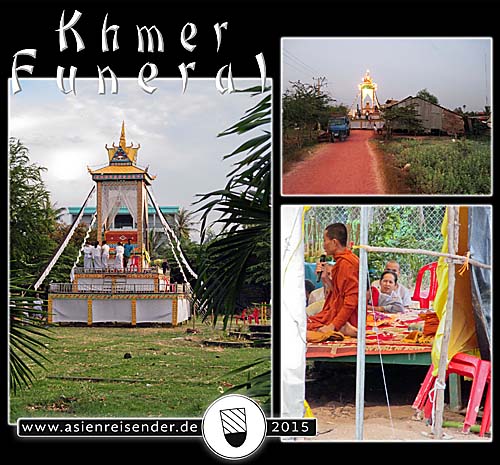
The colour of mourning in Buddhism is white. Usually there is no burying, but a cremation. Parts of the body, preferable teeth, remain in the family as amulets and talismans. It's often so that the cremation does not burn the whole body to ashes and parts of the body remain. That is seen as a wonder in the way that the spirits are stronger than the fire. Many people believe that, I heared it also repeatedly from convinced Westerners. In fact must the temperature of the fire be at least 900 degree celsius or higher for an hour or more to completely burn a human body. Since the temples and crematories are ill-equipped and the monks don't know that, they have problems to reach high temperatures. Too low temperatures cause the wonders then. And wonders are good for the monastery...
The image top right shows a coffin on kind of a special stage inmiddle of a road. The road is therefore blocked and everyone who has to pass by has to drive a huge detour of several kilometers. There are no signs to announce the blocking in advance and no detour advised, as never ever is anything organized in this rotten country.
The picture right below shows a monk giving a sermon. It's very, very noisy.
Images and photocomposition by Asienreisender, Kampot, 2015
However, dying is somewhat what should be accompanied by the family and a professional. The professional is a Buddhist monk who comes from a nearby temple. The monk performs some rituals, most of it is holding a sermon and chanting. This can last over a couple of days, up to eight days. One can imagine what starts happening with a corpse in the tropical heat after two, three days.
A party service is hired, supplying music equipment, tables, food etc. As early as possible the notorious din starts. The first thing to hear is the unavoidable, shrieking backcoupling. Someone at the microphone says a few times "Hello - hello - hello". That's the upbeat for at least 24 hours noise terror of the worst. It's followed by a speech which not seldom sounds aggressive and hateful. Then, for the next hours, a monotonous xylophone music is played. It get's repeatedly interrupted by the sermon of the monk and the chanting. Later, the funeral music continues. Next morning the din starts again at around 4 a.m. Sometimes its over within 36 hours, sometimes it lasts longer. Sometimes it get's repeated after a couple of days and again after 100 days. Recently it happened, that at late night time, when everyone in the neighbourhood was in bed since long already, one of the mourners took the microphone again. He tried to held a speech, but failed because he was completely drunk. Out came merely an aggressive, wolfish stammering of a full-scale retard. After this sick performance, music was played for another hour.
All the relations between Khmers are business-relationships, all are based on money. It's not only that the monk get's paid for his role. It's that as many guests from the remotest members of the family, plus colleagues, aquaintances, neighbours and more are invited. They all have to pay an amount of money, put into an envelope with their name on it. Certainly there is much gossip afterwards who paid how much. At the end the party was also good business; it generated family income.
10.
What's Wrong Here?
So, why are things so odd here? How comes?
For all the nuisances in the country, usually the Khmer Rouge and Pol Pot are hold responsible. Evil has a face. However, that's an abridged view. Things are much more complex and have evolved over a long time.
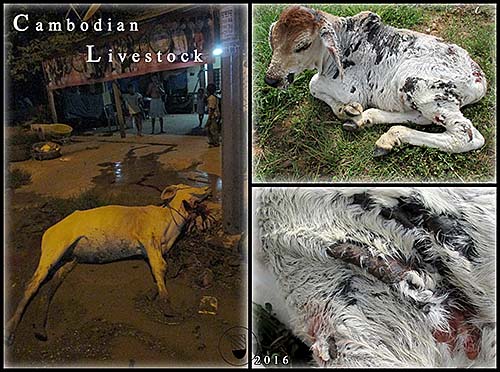
Everything is run-down, neglected, messed-up, of the lowest quality in Cambodia. Contemporary Khmer lack any skills, even basic skills are seldom. The peasants in the countryside, still the majority of the population, does only the least to maintain their farms. They don't properly fertilize their soil, they produce rice and vegetables usually of low quality and gain low yields, the livestock is mistreated and often very sick. Asian flu and skin diseases at cattle are a common thing. No one cares for anything.
If we look back to the times of the Angkorean empire, which was based on a huge, hydraulic irrigation system to irrigate the fields which allowed them to gain up to four harvests a year, we have to admit that this was a grand cybernetic achievment which required good planning, engineering knowledge and technical skills. The hydraulic civilization of Angkor lasted about 600 years, that were twentyfour generations, if you count a generation as 25 years. Nowadays, the Khmer can not build a proper bathroom anymore. This nation retarded far below what they were a thousand years ago. Images and photocomposition by Asienreisender, Kampot, 7/11/2016, 2017
Khmer People have a long history, lasting back up to 2,000 years. All this history was coined by the despotic rule of ruthless ruling classes. Total obedience was always required, who didn't follow this demand got brutally killed. There are historical witnesses for this, like Zhou Daguan, who described 13th century Angkorean society in his report 'The Customs of Cambodia' for example. Despotism and a highly stratified, on violence based society shapes a very distorted social character of a society, which is deeply engraved into the psyches of the individuals. Khmer despotism was, after all we know from historical records, of a particularly necrophile kind. All the Cambodian rulers over history until today were of an extremely autocratic and selfish kind. That throws a long shadow over the People of Cambodia.
Over the course of history it looks as things would have changed, but the changes were merely on the surface. After the downfall of the empire of Angkor, the Khmer turned from imperialism to banditry. Weak monarchs couldn't control the countryside and often enough allied with bandits and pirates. Henri Mouhot gives a lively example of that in his travel narrative 'Travels in the Central Parts of Indochina'. The French colonial rule was exclusively based on the exploitation of the country and it's resources. After the independence in 1953, king Norodom Sihanouk followed the old authoritarian, autocratic and egocentric pattern and also allied with the bandits of his time - the Khmer Rouge.

Poverty is rampant in Cambodia, one of the least developed countries in the world. It can be compared with sub-Sahara Africa, with the difference that it has two much richer neighbours it is profiting from, and the support of China. Apart from the very small ruling class of the Khmer Rich, what is merely a few dozens families, and a staff of functionaries who grow wealthy (the so often praised 'emerging middle-class', the henchmen of the upper ten, what is estimated not more than ten percent of the population), the mass of the people are bitterly poor and live since generations in deprived circumstances. Image by Asienreisender, Kampot, 7/2016
Peter Scholl-Latour was a French/German reporter who came to Indochina in 1946 with the first French landing boats at the beginning of the First Indochina War. Scholl-Latour travelled Southeast Asia for decades, until the 1980s or 1990s and reported extensively on the world region. He was repeatedly captured by the Communist Plathet Lao and the Vietcong, and described them as being of a good moral and discipline. They treated him fair and respectfull, didn't steal from him and didn't take bribes. That was not so with the Khmer. The Cambodians he described as cruel bandits, and it didn't make a difference if it were the Khmer Rouge or Lon Nol's government troops (Peter Scholl Latour: 'Der Tod im Reisfeld').
The Americans finally bombed the Khmer Rouge in power. Estimated 600,000 people lost their lives due to American carpet bombing (that's known as Western 'Democracy export'). The result was another despotism, this time the ultranational (they called it Communist, there was nothing Communist in it) despotism of Pol Pot and his Red Khmer movement. In this time the Khmer tried to commit autogenocide, a term for what happened in this society, and is unique in history: a nation tries to kill itself. And there is no doubt that they would have succeeded, if not the Vietnamese would have interfered. A three years longer rule of Pol Pot / the Khmer Rouge, and there were only few Khmer left. Despite being rescued by the Vietnamese, the Khmer hate them more than any other nation. What I hear in contemporary Cambodia is that the Khmer all too often blame the Vietnamese. Well, the Vietnamese was another occupation regime and at the end stands the Hun Sen Regime. A thoroughly sinister history with no happy end, not even a silver stripe at the horizon.
So, one has to consider that there was war here from 1970 on up to actually the end of the 1990s, when the last Khmer Rouge and the new Cambodian government finally came to a peace agreement. Which included the reintegration of the Khmer Rouge into Cambodian society under (almost) complete impunity.
This extremely brutal course of history here requires explanation. The neighbouring countries Laos and Vietnam suffered certainly more and defenitely longer under the American aggression in the Second Indochina War; why turned it that extremely bad particularly in Cambodia?
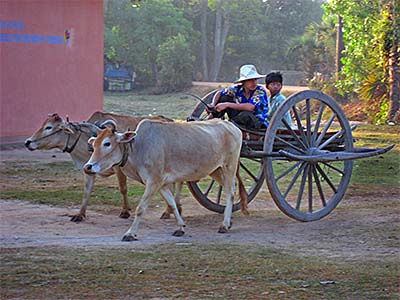
Things are more than just a bit back in time. Khmers are not at all technical, and their mindset lays back in the times of the dawn of history. Image by Asienreisender, Roluos Group, Siem Reap, 12/2006
That has certainly to do with the characteristic Khmer mindset. Alexander Hinton gives explanations for that in his work 'Cambodia in the Shadow of Genocide'. He describes a Khmer custom which includes a severe code of revenge against wrongdoers. Unlike the archaic principle of the Old Testament, where 'an eye for an eye' is demanded for revenge, in the Khmer psychology it must be an increase, an escalation: a head for an eye. Unproportional revenge. Many barbaric customs play a role in this society. There are several eye witnesses (like that of the American ambassador in the 1970s), who witnessed killings on streets in Cambodian towns, afterwards the victors opened the bodies of the killed, cut the liver out and ate it. The atrocities in Democratic Kampuchea were all over a caleidoscope of horror.
In her very readable book 'The Shock Doctrine', Naomi Klein describes a method to deprive and destroy people's personalities, developed in the 1950s by a psychiatrist named Ewen Cameron. He treated patients massively with electroshocks and high doses of psychopharmaca, kept them over months in complete isolation, deprived them from daylight and other basics. These people totally retarded, couldn't think and speak afterwards and relieved their needs onto the floor. The CIA became interested in these methods and worked out an application of the principle on whole nations. Shock and awe. Bomb whole countries back to stone ages and far beyond.
That's what happened in Cambodia, and it's a running pattern in the contemporary wars in Yugoslavia, Afghanistan, Iraq, Lybia, Syria and more... it's continuing and more and more countries, whole world regions are getting destroyed by applying the method of shock and awe. However, the initial idea of Ewen Cameron was to afterwards build up a new personality. A personality by design. That never worked in individuals, though.
The political implication of shock and awe is to create a new social character. That of a free-market personality, aligned to the brave new world order of global neoliberalism. In this case it seems to work. The Cambodian people are clearly retarded as the result of the decades lasting 'shock therapy', but they are perfectly adapted to the free-market ideology. If they have anything in their minds, then it is to make money, money, money, by all costs. They are also phantastic, unreflected consumer idiots.
10.
Sources
This article is based on years of practical experiences and observations. Moreover it's based on a number of publications. You find a list of them on the Literature page. Among them are as already mentioned Zhou Daguan's 'The Customs of Cambodia', Henri Mouhot's 'Travels into the Central Parts of Indochina', Peter Scholl-Latour's 'Der Tod im Reisfeld', Alexander Hinton's 'Cambodia in the Shadow of Genocide' and many more. However, it's not at all exhausting; it comes together with uncounted articles from newspapers, magazines, (qualified) websites and movies, both fiction and documentary. Sometimes, a good talk with a connoisseur of a certain topic provides me with facts, ideas, inspirations and innovations and/or reveals a mistake.
